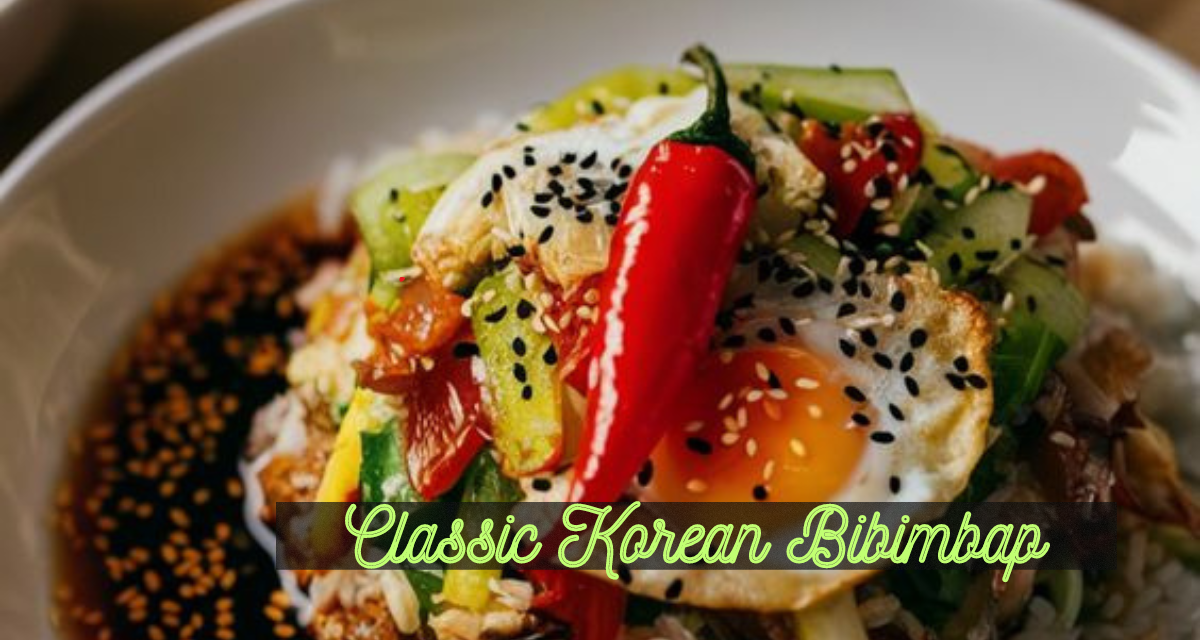The complicated tapestry that is Korean food includes bibimbap, which is often recognized as one of the most intriguing and enticing meals that can be found in Korean cuisine. One of the dishes that can be found in Korean cuisine is bibimbap. One of the many intricate elements that make up Korean cuisine is the dish known as bibimbap. When it comes to dishes, it is typically considered to be one of the more appetizing selections available to choose from. All of the features that are included in this well-known Korean dish, which gets its name from the literal translation of “mixed rice,” are examples of the spirit of Korean cuisine. These traits include the vibrant colors, flavors that are in perfect harmony with one another, and varied textures that are included in the dish. In accordance with the literal translation of the statement, it was identified by the name that it is commonly known by. The name of this particular dish has become virtually synonymous with the cuisine of Korea over the course of the previous several years. In the beginning, we will embark on a gastronomic adventure that will take us through the history of bibimbap, its components, the production of bibimbap, and the cultural significance of bibimbap. The cherished traditional Korean food known as bibimbap will be revealed to us as we progress through our journey. We will explore the numerous layers that come together to form this delicacy. Furthermore, the dish that is commonly referred to as bibimbap is not only a food that is regarded to be traditional, but it is also a dish that is believed to be representative of the culture that is prevalent in Korea.
Background and Development
One might compare the experience of learning about bibimbap to that of embarking on a voyage through the history of how Korean food has developed over the course of time. The true history of bibimbap is lost in the annals of time; but, it is claimed to have emerged as a strategy to make use of leftovers by combining rice with a variety of vegetables, meat, and sauces in order to generate a dinner that was both healthful and satisfying. At the time of its inception, bibimbap was a straightforward dish that was particularly well-liked by rural residents. On the other hand, throughout the course of time, it has evolved into a highly esteemed staple of Korean cuisine that is lauded for its versatility, flavor, and aesthetic appeal.
A Bibimbap’s Structure
Bibimbap, at its heart, is an inventively basic dish that showcases the splendor of in-season, fresh ingredients. Here are some traditional ingredients used in bibimbap:
Steamed rice is the base of bibimbap and the perfect medium for the presentation of the other components.
veggies: Bibimbap is known for its colorful array of veggies, which are generally cooked and seasoned to perfection. Typical ingredients include spinach, carrots, bean sprouts, mushrooms, zucchini, and radish.
Beef (bulgogi) is the main protein in bibimbap, but other meats like chicken, pork, tofu, or shellfish can also be used to make it more flavorful and substantial.
Poached or over-easy egg: The bibimbap isn’t complete without an egg, and the silky richness of the yolk makes it the show-stopper.
Gochujang, a fiery fermented chile paste, is a traditional condiment for bibimbap. It provides a spiciness and an umami punch to the meal.
Bibimbap isn’t complete without the finishing touch of toasted sesame oil, which adds a nutty scent and a richer flavor to the dish.
Get Ready and Give Your Presentation
The preparation and presentation of the dish are just as important as the ingredients when it comes to making bibimbap. Arranged in an eye-catching fashion above a bed of steamed rice, each ingredient is cooked independently to achieve ideal texture and flavor. Vegetables scrumptiousness is an invitation to indulge all senses, thanks to their dazzling array of colors and textures.
Importance in Cultural Terms
As a symbol of balance, peace, and unity, bibimbap is highly esteemed in Korean culture and goes beyond its gastronomic excellence. Incorporating the components one by one right before consumption is more than just a technique in cooking; it’s a ritual that captures the essence of family dinners and shared memories. Enjoying bibimbap together on holidays and special events is a common way for Koreans to celebrate and bond over a common passion: delicious cuisine.
Differences between regions
Bibimbap, like any well-loved dish, has given rise to a plethora of regional variants, each of which showcases the distinct ingredients and cooking techniques of its home country. Dolsot bibimbap, served in a hot stone bowl, is a spicy and savory dish; hoe-deopbap, made with raw fish and fresh vegetables, is light and refreshing; the list goes on and on, providing a tempting insight into Korea’s varied culinary terrain.
Bibimbap: A Delightful Journey in Cuisine
Finally, bibimbap is proof that Korean food is full of passion, innovation, and inventiveness. Bibimbap takes diners on a gastronomic journey into the very essence of Korea with its vivid hues, robust tastes, and extensive cultural background. No matter if you’re eating it in a busy Seoul restaurant or whipping it up in the comfort of your own home, bibimbap is always a joyous occasion—a toast to life, love, and the simple pleasures of sharing delicious food with people you care about.


:max_bytes(150000):strip_icc()/classic-korean-bibimbap-recipe-2118765-step-011-acab906539594dc9a668c7fbb753c43d.jpg)
